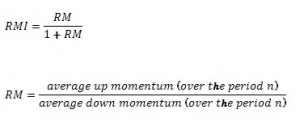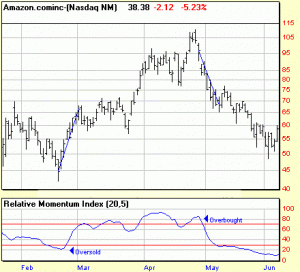The Relative Momentum Index function determines the internal momentum of a field using the number of upward and downward price changes across a given number of bars over a given period of time.

The Relative Momentum Index is based on a ratio of the average upward changes to the average downward changes over a given period of time. The individual changes are calculated for the given number of days. This is an extension of the Relative Strength Index, which uses a momentum period of 1 to calculate day-to-day changes.
As an oscillator, the RMI exhibits the same strengths and weaknesses of other overbought / oversold indicators. During strong trending markets the RMI will remain at overbought or oversold levels for an extended period. However, during non-trending markets, the RMI tends to oscillate predictably between an overbought level of 70 to 90 and an oversold level of 10 to 30.
Since the RMI is based on the RSI, many of the same interpretation methods can be applied. In fact, many of these “situations” are more clearly manifest with the RMI than they are with the RSI.
* Tops and Bottoms: The RMI usually tops above 70 and bottoms below 30. The RMI usually forms these tops and bottoms before the underlying price chart.
* Chart Formations: The RMI often forms chart patterns (such as head and shoulders or rising wedges) that may or may not be visible on the price chart.
* Failure Swings: (Also known as support or resistance penetrations or breakouts.) This is where the RMI surpasses a previous high (peak) or falls below a recent low (trough).
* Support and Resistance: The RMI shows, sometimes more clearly than the price chart, levels of support and resistance.
* Divergence: As discussed above, this occurs when the price makes a new high (or low) that is not confirmed by a new RMI high (or low).
Like in case of all overbought/oversold indicators, the RMI shows similar positive and negative sides. When the markets are in strong trend, the RMI will stay at overbought or oversold levels for a long period. Otherwise the RMI conduces to predictably fluctuate between an overbought level of 70 to 90 and an oversold level of 10 to 30. While the RSI differs from the price, the price will ultimately improve in the course of the index.
